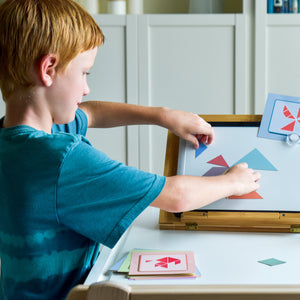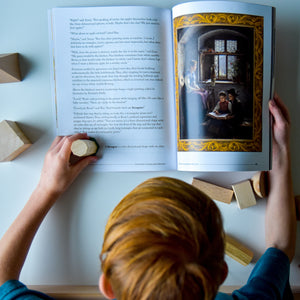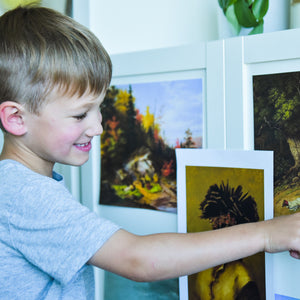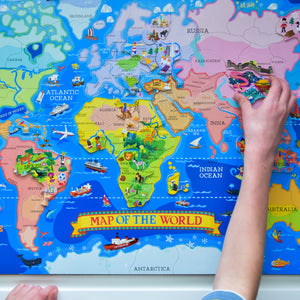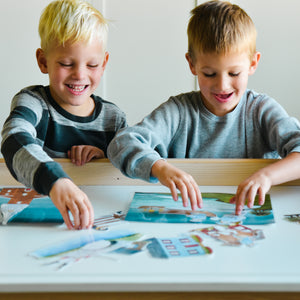Talking about Art with Children

Sit in with Tresa and her two children in this YouTube video for an art talk about the painting, "Huron Hunters Camping at the Big Rock of Lake Lagon" by Cornelius Krieghoff.
As I walked out of the high school classroom where I had just finished my AP Art History test, I massaged my cramped hand and blinked my dry, strained eyes furiously. I remember thinking, “Now I can just love art and not have to analyze every inch of it. I can soak in the colors, the faces, and the movement without writing a sample essay in my head. I get to just feel the beauty of it.”

"The Concord Stage" by Edward Percy Moran, 1911
I desperately wanted to share my love of art with my children. As a homeschool mom, I was so excited to include art, in all its forms, in our studies, but I found myself disappointed that I couldn’t seem to make it happen consistently. Art study and appreciation were always being pushed to the end of the day, when we were tired and cranky, and my children gave short, unthoughtful answers just to be done. Some days it didn’t happen at all. I was praying to know how to help my children love art. The Mindful Heart answered those prayers.

"Mrs. Schuyler Burning Her Wheat Fields on the Approach of the British" by Emanuel Leutze, 1852
One of my favorite parts of the Mindful Heart curriculum is the art! I love how it flows with daily learning. It belongs; it is not tacked on at the end as an afterthought to always be forgotten. It has been a wonderful blessing in our family to look at inspired art, to have meaningful conversations about it, and to have fun with it.
"The Iceburg" by Frederic Edwin Church, 1861
How do you talk with your children about art? How do you help build connections with beautiful paintings? What do you do if your children are not interested in art and would rather not participate? Be prayerful, lead by example, show enthusiasm for art, and let your children’s love of art grow at their pace. In our family, art appreciation was not an immediate success. It took time, effort, and creativity to pull my children into a painting.

"Huron Hunters Camping at the Big Rock of Lake Lagon" by Cornelius Krieghoff, 1862
Using the painting Huron Hunters Camping at the Big Rock of Lake Lagon by Cornelius Krieghoff, found in the Year 1, Unit 1 Picture Pack, as an example, I would love to share some ideas that have helped us in learning to love art.
First, let your imagination wander as you consider the people, animals, and landscape. What in the painting draws your eye first? What is this painting’s story? Is there a hero in this painting? What do you think the hunters are talking about? Is the mood light or somber? What might their plans be for the day? Who built the canoe? Why did they pick that spot to rest in? Have they camped there long, or did they just arrive? What is the name of the dog? Is it an energetic puppy or a wise, experienced hunting dog? Imagining the story of this painting will bring it to life and create a space for it in your child’s memory.
Second, consider composing a story together as a family, with each person contributing ideas that can be blended together. Or encourage each person, parents included, to imagine his or her own unique tale. Allow time for each person (again, parents included—let your child see you interact with the painting as well) to share his or her entire story out loud. Each person will have a different narrative, and that is fantastic! Kindly remind every family member that each contribution is valuable and deserves attention and respect.
Third, discuss color and movement. What is your favorite color in this painting? Maybe it is the red or gold of the trees. Is there something else this color reminds you of? Perhaps the red reminds your children of the cherries they ate for breakfast or the gold reminds them of the bells that hang on your Christmas tree. What textures can you see? Keep discussing the painting and ask questions to cultivate multidimensional answers. With encouragement and practice, help your children to think of rich adjectives to better describe the textures they are thinking of, such as crunchy, snug, rippled, satiny, blistered, or downy. Are there any indications of movement? Might there be a breeze pushing the clouds slowly along and ruffling the leaves, or is the day calm and quiet? Ask about the reflections in the water or the shadows of the forest.

"The Young Bull" by Paulus Potter, 1647
Questions are the gateway to an exploration and interest of all art. Start with broad questions and then narrow in, based on their individual responses. Encourage discussion between children and let siblings ask respectful questions of each other’s opinions. “Why?” is an amazing question, and we need to set aside enough time to really let each of our children explore his or her ideas. Gently encourage children to express their thoughts with clarity and meaning. Please always remember: every opinion deserves consideration. Praise effort but don’t force participation. Ideas will come with time and practice. Let art from the Mindful Heart inspire creativity, fun, sharing, and discussion in your family. What a blessing it can be for our homes and the hearts of our children!

- The Mindful Heart


